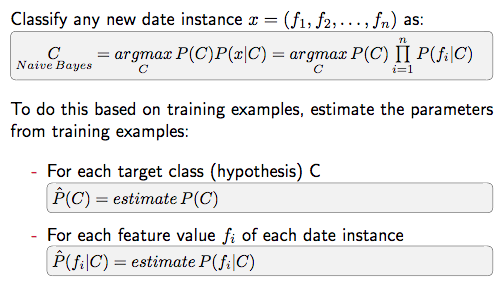I understand the basic principles for the naïve bayes classification with one feature:
$$ P(Class|feature) = (P(f|Class) * P(Class)) / P(f) $$
We have a dataset that has the following attributes/features:
day | outlook | temperature | humidity | wind | play
- Day is just a number (sequence)
- Outlook can be [sunny | overcast | rain]
- Temperature can be [cool | mild | hot]
- Humidity can be [normal | high]
- Wind can be [strong | weak]
- Play is [yes | no]
Now, we have a new instance: today = (sunny, cool, high, strong) and we want to know if we can play outside. This is Bayes classification with multiple features, as you've recognized.
The image below is a slide from my course at uni, however I don't understand anything of it.
Who can explain to work out the above formulas to me like I'm five, maybe with Python code? I'd like to understand how I can do naïve bayes classification for multiple features.


P(Class|feature) = P(feature|Class)*P(Class)/P(feature)). However, when I get multiple features (for example outlook, wind and humidity) I get lost with the formula in the image I included. I just don't understand what to do, how to tackle this. $\endgroup$